
June in the garden is, much like May, another busy month! With the light nights and long days, we always seem to get a lot done. The fear of frost is now behind us and seeds planted last month are now young plants. Less hardy plants such as courgettes, runner and French beans that were planted in pots inside last month can be planted out and with the warmer soil temperature, seeds will germinate and grow quickly.
Slugs are in full force and will need careful ‘management’ and weeds are unfortunately also growing well. Regular weeding sessions with the hoe will stop them from taking hold and becoming a big job later on.
There are many plants that need planting out and there are a number of seeds to sow in June, some of these crops will be for harvesting over the winter. We are on heavy clay soil here which can be a challenge if the weather isn’t just right for sowing seeds. I prefer starting many of my seeds in trays or plugs which will then be hardened off and transplanted into their final planting position. This gives them a fighting chance against slugs and snails and any that are spare can be used to replace gaps if they get eaten.
To ensure a continuous harvest, lettuce need to be sown regularly (2-3 weeks). By now of course, slugs and snails are a real problem and can wipe out a row of germinating lettuces overnight. To save sowing too many, having to thin them out, or lose them to the slimy free-loaders, I sow a pinch of seed into a seed tray and once developed, prick them out into plugs. With a good root system, they are less likely to be wiped out. My ‘slug control’ is old coffee grounds – scatter on the soil around the new plants. This seems to keep them at bay long enough to allow them to become well established.
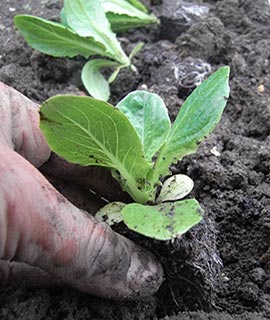
Once the soil temperature is greater than 13⁰C, pot grown plants can be transplanted. Seed can be directly sown into the garden as well if you didn’t start them off in this way, although watch out for mice as they like the seed and will dig it up. Keep them well watered.
Peas need rich soil and mustn’t have too much water. Again, I tend to start them in pots (due to our heavy clay soil) and plant them out once established. Sow into damp compost and do not water until the shoots appear to prevent losing them. They can also be planted directly into the garden but remember slugs love them and mice will dig them up as well.
Continue planting maincrop varieties, either directly sowing into rows, or into seed trays / plugs for later planting. Eat while the roots are tender, about the size of a golf ball. I thin week by week, with the last of the thinning only a week or two before the crop is harvested. As they grow, they jostle for space and push one another apart and roots can be removed and eaten along the way as they become large enough.
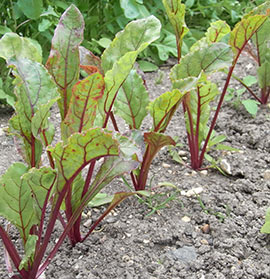
Carrots can be sown monthly from March through to early September (with fleece for protection over late sowings) for a continuous supply. Maincrop carrot varieties sown in June usually have the advantage of missing the main flight of the carrot root fly. Sow seed in rows directly into the vegetable garden. I thin twice, once to create some space and once to have delicious baby carrots before they overcrowd the main crop.
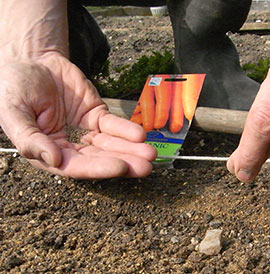
Sow directly outside into drills and thin do that plants are an inch or so apart. Sowing twice monthly, it is possible to have a continuous supply from May through to September.
Chinese cabbage likes cool weather and during warmer spells will often bolt but I like Chinese cabbage because it can be grown right through the autumn and even into winter with a cloche and is great in stir-fries.
Broad beans are hardy plants and easy to grow yet they have a poor reputation. Young broad beans the size of your thumb are much tastier than the fully-grown beans, which tend to be leathery. Young broad beans also store well so excess beans can always be picked and frozen before they grow too large. Sowing twice a year directly into the ground will provide you with a good supply. Sow now for a crop in September and sow again in October or November for a May or June crop.
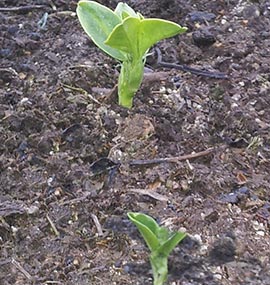
Perpetual spinach makes a fantastic cut-and-come-again salad crop. Sow now for a late summer crop, germination is far quicker (about a week) than our friend Swiss chard. Dominant is the variety I use that can be sown every month during the spring and summer to keep a continuous supply well into the autumn.
Chard is easy to grow and long lasting so is a really worthwhile thing to grow. The leaves are used in much the same way as spinach and the stems are excellent in stir fries. Whilst the ruby red varieties of chard look pretty, I’ve found the white chard far better for both taste and hardiness. Germination can be slow but sowing now should give you a crop in September / October that will keep into the winter. Sow into rich / manured soil and it will do well.
If you sowed into 3″ pots as suggested in May, these can be planted outside now. Keep a few spares to replace any that get damaged or eaten by slugs or snails.
If you sowed celeriac into trays earlier in the year then it should now be planted out. Keep well watered during dry spells or they will go to seed and not swell in size.
Sweetcorn should only be planted when the night time temperatures hold above 10⁰C. I usually sow some into 3″ pots to get them started and hold off transplanting them if the weather isn’t settled until July. The plants are usually 4-6″ tall by the time they go out. They don’t like having their roots disturbed so I take extra care when transplanting. They are ready to harvest through September.
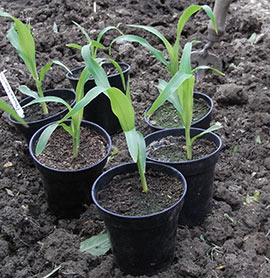
Swede likes a light, manured soil so be careful where you grow them. Swede needs 20 weeks to mature so sowing now into plugs or directly if slugs aren’t too much of a problem. They over-winter well in the ground so are a useful winter crop to have in the garden. Space plants 9″ apart when thinning. Rich in vitamin C, niacin and calcium, they are well worth growing.
Pumpkins and squash are massive plants and you’ll need a lot of space to grow them. Pumpkins are especially hungry and so must have lots of organic matter in the soil but should also be well watered to do well, so keep this in mind with the location of them relative to your water supply. Mice love the seeds so make sure you either germinate the plant in a pot or set some mouse traps nearby!
If you sowed any brassicas in trays or pots to prevent clubroot then you should get these planted out at the beginning of the month. See Jobs for June in the Garden further down this page for advice on fitting collars to prevent cabbage root fly and preventing cabbage white butterflies from laying their eggs on the leaves that will hatch into hungry caterpillars.
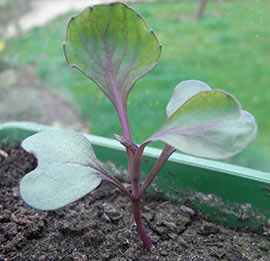
Plant radishes in small quantities (a 2ft row is usually enough) weekly if you want a continuous crop and do not let them dry out. If they dry out and then have a soaking, they will respond by growing too rapidly and will split. The cooler months are usually better for growing radishes and I tend not to grow them in July and August. Radishes do grow quickly but the down-side is that they will spoil (the interior goes spongy) if they are not pulled up and eaten within a day or two of reaching maturity.
Cauliflowers are difficult to grow and I have to admit I have had a lot of failures since they would mature too early, producing a small head (called premature curding). Once you notice it, it’s too late! June is about the time to transplant cauliflowers into the garden from trays or the seed bed and is a dangerous time for them because of the stress they are put under being moved. The secret is to dig in a lot of compost and manure where they are going to be transplanted, to transplant them early (before 4 weeks) to reduce the stress, thin them early and keep them well watered during warm weather.
A lot of the small broccoli florets that you buy in the shops are in fact Calabrese! It is basically a Summer Broccoli. It is not too late to sow now, in fact it is very fast to grow being ready for harvest in around 10-12 weeks. My favourite variety is Romanesco which with it’s pointy florets is a work of art in itself!
If you didn’t plant Chicory earlier in the year, then you can still plant it in early June. Chicory does best in well-drained, rich soil. Roots can be used as an alternative to coffee but we only use the leaves in salads after blanching to reduce the bitterness a little.
May is actually the busiest time for me in the greenhouse and by June, most of the planting is done, but if you are in the North of England or Scotland, you are probably a few weeks behind in planting and even if you aren’t, there’s still time to plant pot grown tomatoes, cucumbers, sweet peppers, chillies and aubergines if you haven’t already done so.
Cordon (indeterminate) varieties of tomatoes require a good stake and ties to support the plants vertical growth and the weight of developing fruit. As they grow, pinch out the side shoots that develop. This will prevent too much bushy growth and maintain the shape of the plant, keeping it growing upwards. It isn’t necessary to pinch out side shoots on bush (determinate) varieties.
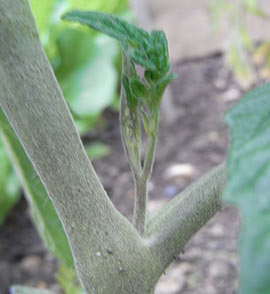
June is the month for putting measures in place to control pests such as aphids, carrot and cabbage root fly and to continue the battle with the slugs. It can also be hot so young plants can dry out quickly if you don’t keep on top of watering. Here are my jobs for June in our garden:
Aphids such as greenfly and whitefly can be controlled organically in both the greenhouse and garden. Introduce a predator such as lacewing, ladybird, hoverfly, predatory gall midge or parasitic wasp. These can be bought as larvae and will mop them up before they become a bigger problem. Predators can be purchased online and in some garden centres. They are usually called “biological controls”. Introducing bug boxes in the garden can help them thrive.
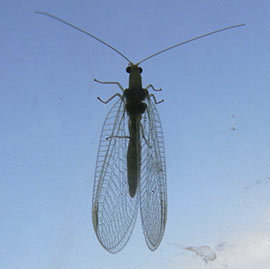
Young plants may need to be watered if the ground is dry. It is best not to water when the sun is strong in the middle part of the day as the leaves may be scorched. Water in the morning or evening. Light watering only soaks the surface of the soil which will cause roots to look for water here. It is better to give plants a good soak and then let the ground dry out so that roots will grow deeper and be more resistant to dry spells and pull up nutrients from lower in the soil.
The female carrot fly cruises at a couple of inches above the soil level. She finds carrots (but also parsnips, parsley and celery) by smell and lays her eggs at the base of the root. Her eggs hatch into tiny grubs and you’ll see tiny brown tunnels in the tops of the roots. Carrot fly infestation can be prevented by disguising the smell: sowing between rows of onions, near chives, or by physical means: covering with horticultural fleece or sowing in raised beds.
Another pest that attacks the roots of brassicas such as cabbages is the cabbage root fly. It causes them to collapse completely and when removed from the soil, you will find white grubs eating the root. The adult cabbage root fly has to lay her eggs at the base of the plant. A small piece of materiel with a slit to allow it to be placed around the root will stop her from doing this and prevent the problem. You can either make these yourself out of a suitable material or buy them ready made.
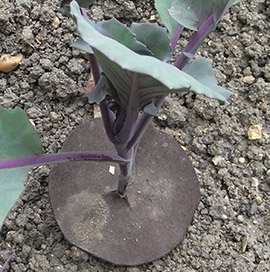
Cut chives that have flowered down to a couple of inches from the ground. This will encourage fresh new growth instead of seeds and woody stems in the coming months from the current top growth. Don’t forget to leave a little un-touched to provide enough to last until the new growth comes through!
June is the month when cabbage white butterflies will lay their tiny yellow eggs on the under side of your brassica leaves. You can net brassicas to prevent the butterflies from reaching them (make sure the netting is small enough, some of the bird-nets are not) or squash the eggs before they hatch into caterpillars.
Slugs and snails are out in force now, especially if we get a wet spell. I have found an effective control method is to dig in coffee grounds into the top inch of soil around plants and to go outside and pick them off plants during wet spells during the evening or early morning. Keeping a few spare plants to fill in any gaps and only planting out strong / well established plants also helps. Established, healthy plants can usually survive some slug damage.
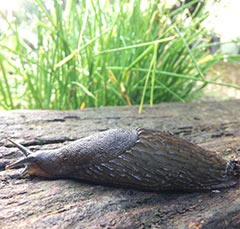
Jobs in the Fruit Garden
As the temperature rises in June, it’s essential to keep fruit well watered but to get the best from your fruit garden, thin developping fruit on trees, summer prune fruit bushes and control a few nasty pests that can spoil your crop.
Female Codling Moths fly in and lay their egg on apple trees this month and next. Caterpillars chew into the fruit core from the top of the apple and are certainly not nice to bite into! Pheromone traps that smell of the female moth work by trapping the male moths on sticky greased paper. Without fertilisation, females can’t lay eggs. One trap is usually sufficient for every 5 apple trees.
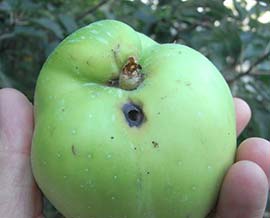
The main pruning of gooseberry bushes is in the winter when the leaders (framework branches) are cut back by about a quarter and side shoots are reduced to 2 buds. Young bushes can produce a lot of new growth, so in early summer, it is best to reduce this to let the sunshine in, helping the fruit to ripen and allowing air to circulate.
As with gooseberry bushes, red and white currant bushes also benefit from summer pruning to keep the centre open, letting the sun in and allowing the air to circulate. They should be summer pruned in the same way as gooseberry bushes.
Summer Pruning Currant and Gooseberry bushes – Step by Step
[photos to come June 2014 when I prune!]
You will be cutting new growth which is green. Fruit is only produced on last years woody growth so you won’t be losing any of this years’ developing fruit.
1
Select branches that you want to become leaders (that create your framework) if your bush is young or you want to increase the size of it. Do not prune these.
2
Using sharp, clean secateurs, cut all centre growth to 3 leaves, aiming overall for a wine glass shape.
3
Cut all other new growth back to 5 leaves, leaving framework branches alone.
Pull off the suckers that grow from around the base of fruit trees as these take energy from the tree and serve no useful purpose.
Thin developing plums and pears, apricots, peaches and nectarines. Thin apples at the end of the month or early July.
June is always an exciting month for me: we start to see the first ‘real’ crops coming out of the garden! Whilst we have small tubs of cut and come again or potatoes before June, they don’t usually provide much more than a meal or two at a time for us but in June, we can start to see more vegetables arriving in the kitchen, not to mention our first Strawberries!
Cut and come again salad leaves are probably one of the easiest things to grow and will withstand a wide range of conditions. Given some reasonable soil on a south facing plot, they take just 4 to 6 weeks to grow. Leafy green lettuce leaves are most nutritious at the seedling stage so are very good for your health too.
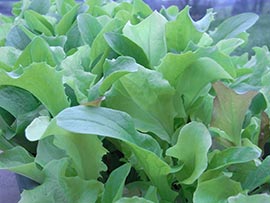
Asparagus can be picked -but stop picking it in mid to late June and allow the ferns to grow or you risk weakening the plants. Leave the ferns to go brown in Autumn before cutting to give the plants a chance to photosynthesise for as long as possible, to store up energy for the next season.
If you overwintered broad beans by planting them in November you should have a crop of tender young beans now. Broad beans have a bad reputation for being leathery: Make sure you only harvest small, young, tender beans or risk being put off growing broad beans for life!
Lettuce is by far the most grown vegetable we grow in our garden and greenhouses. As we come to the end of the winter grown varieties in March (Winter Density being my favourite semi-hardy variety) there is usually a short time when we have only cut and come again grown in pots in the greenhouse. By June though, spring sown lettuces are in good supply. I like Cos varieties the most, (Counter, a ‘Little Gem’ X ‘Romaine’ variety) is one of my favourites for flavour and resistance to bolt during the warmer months. It has also performed well during wet summers.
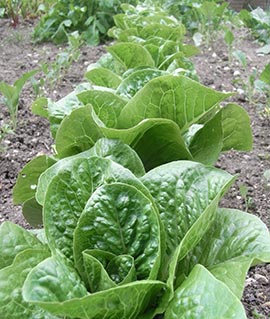
Can be sown in early spring, so by now we have a good supply. One variety we sow almost all year round and is slow to bolt is Dominant.
Radishes are a fast growing crop and April sown radish should be big enough to be harvesting now.
Summer sown cabbages that were over-wintered are a good gap filler during the spring. Although June is the tail end of what we produce from our August sowing, they are still very welcome in the kitchen. The variety I like the most is Spring Hero.
Peas are now in plentiful supply. You simply cannot buy peas as tasty from the shops and I could not be without home-grown peas. If you have children, you will also appreciate seeing how much they enjoy picking and eating peas straight from the pod.
There should be a good supply of strawberries ripening up during June. If it is a hot month, they will benefit from watering to help increase the size of the fruit. Straw can be used around the plants to help ripen the fruit and keep it off the ground and away from slugs when it’s wet. Don’t forget to net strawberries so the birds don’t steal your crop!
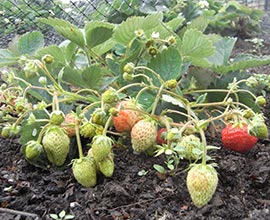
Parsley, Chives, Coriander, Chervil and Dill can all be harvested this month. There’s nothing quite like having the first new potatoes (I grow Swift which is one of the earliest) obliterated with butter and a generous helping of roughly chopped flat leaf parsley thrown over the top. Chives are big enough to cut now and are used mainly in Omelettes and rolled onto goats cheese whilst Coriander is used on stir fries and curries. We don’t grow Chervil and Dill now since we don’t use either of them much.
We have heavy clay soils here so growing carrots can be challenging. I cover the ground in February with a cloche and improve the drainage by adding sharp sand to the soil where I am going to sow the seed. I fork in some more sand in the drill before sowing in early March. I find Early Nantes a good variety for spring sowing and by the end of June we have a good supply of carrots. Water regularly if June is hot and the ground is dry or the roots will fork.
A few early potatoes should be available now and are a welcome addition to summer salads. We scrape the soil away gently using our hands to check the size of the tubers. If they are a reasonable size, they can be dug. If we’ve had a cold spring, I will cover them back over with soil and wait a few more weeks.
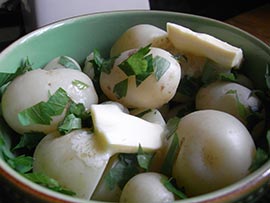
I usually take thinnings out in May and use the tops of these as the small ‘bite sized’ roots in salads. By the end of June, we usually have some fairly good sized beetroot ready from our first sowing. We don’t do anything fancy with beetroot, we boil it with the roots and a bit of the top on (so it doesn’t bleed), let it cool and then slice it as we need it. I love eating beetroot and goats cheese which is even better if it’s rolled in chopped chives.
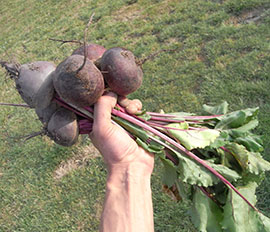
I hope you found ‘June in the Vegetable Garden’ useful. I use this page as my ‘reminder’ of what I should be doing, if not, I always forget something! Please feel free to leave a comment below and if you like it, please consider sharing it.
